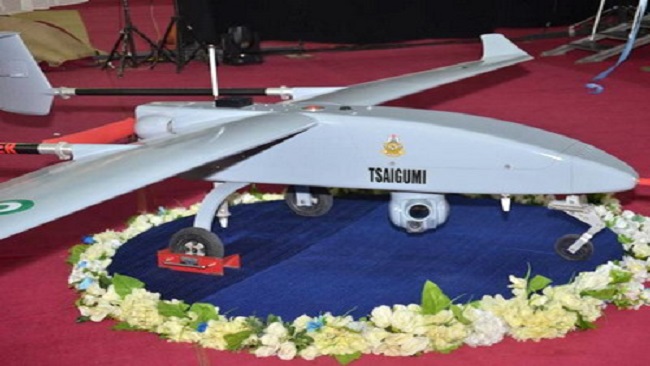Nigerian Air Force unveils new indigenous UAV
The Nigerian Air Force (NAF) has unveiled a new indigenously produced unmanned aerial vehicle (UAV), the Tsaigumi, which will be used to enhance the NAF’s Intelligence, Surveillance and Reconnaissance (ISR) capabilities.
The aircraft was unveiled in a ceremony on 15 February attended by President Muhammadu Buhari, who said “this outstanding accomplishment holds promise of both military and economic benefits to the nation. From the military perspective, the added capacity for ISR provided by Tsaigumi UAV would undoubtedly boost ongoing and future security operations”. He said series production would create employment and generate export revenue.
The Tsaigumi UAV was produced by NAF aerospace engineers in collaboration with UAVision of Portugal. Capable of day and night operations, it has an operational endurance in excess of 10 hours, a service ceiling of 15 000 feet and a mission radius of 100 km. It has a maximum take-off weight of 95 kg and its payload is an electro-optic/infra-red camera system.
The Nigerian Air Force on 4 October 2016 signed a memorandum of understanding with UAVision regarding the production of UAVs in Nigeria. At the time the NAF said the collaboration would lead to the production of four UAV prototypes with two each produced in Nigeria and Portugal.
Air Vice Marshal Olatokunbo Adesanya, Director of Public Relations and Information of the NAF, said on Thursday the Tsaigumi UAV could be used for many tasks, such as ISR, policing, disaster management, convoy protection, maritime patrol, pipeline and power line monitoring as well as mapping and border patrol duties. In addition, it could be deployed for the protection of wildlife, weather forecast and telecast. Additionally, in the maritime domain, the Tsaigumi UAV could be used for search and rescue, coastal monitoring and patrol of Nigeria’s Exclusive Economic Zone.
Mallam Nasir El-Rufai, the Executive Governor of Kaduna State, said his state was willing and ready to procure the Tsaigumi from the NAF, once available. Chief of the Air Staff, Air Marshal Sadique Abubakar, said the NAF would develop another UAV, called Ichoku, which would be Nigeria’s first indigenous unmanned combat aerial vehicle (UCAV).
The NAF said the Tsaigumi UAV is a much more advanced and operationally ready version of the earlier Amebo and Gulma prototype UAVs. The indigenously produced Gulma was unveiled in December 2013 and was produced by the Nigerian Air Force Institute of Technology (AFIT) with the help of aerospace engineers from Cranfield University in Britain. Since 2007, the British institution partnered the AFTI as part of the Nigerian government’s bid to develop an in-house capacity for advanced aviation design, research and development.
Nigeria has previously relied on foreign UAVs, and acquired nine Aerostars from Israel’s Aeronautics Defence Systems (ADS) between 2006 and 2007 and several armed CH-3 UAVs from China, which have been used against Boko Haram militants.
After Buhari unveiled the Tsaigumi he also examined other NAF research and development projects, including a Hind helicopter hydraulic accumulator diaphragm, aviation power pack, unmanned ground vehicle and F4 rocket launcher heat shield cone.
Also on display was a mockup/fuselage component of the NAFSA Eagle eight passenger multirole aircraft. The NAF said it was locally designed and is being manufactured at the Air Force Research and Development Centre to fulfil a variety of roles in the NAF.
It is being developed in partnership with US manufacturer Comp Air Aviation after an agreement was signed in January 2017 with the NAF. Comp Air Aviation (formerly Aerocomp) is based in Florida and specialises in the production of a family of composite kit-built aircraft ranging in size from four to ten seats and powered by engines from 180 to 1 880 hp.
Source: Defenseweb




